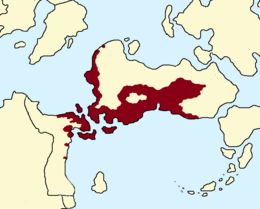Crotalus peliculosa
| Inyurstan Stripe-necked Rattlesnake | |
|---|---|
| File:Inyur crote 02.jpeg | |
| Scientific classification | |
| Kingdom: | Animalia
|
| Phylum: | Chordata
|
| Class: | Reptilia
|
| Order: | Squamata
|
| Family: | Viperidae
|
| Genus: | Crotalus
|
| Species: | "C. peliculosa"
|
| Binomial name | |
| Crotalus peliculosa Peron, 1784
| |

| |
| Range of Crotalus peliculosa | |
The Inyurstan Stripe-necked Rattlesnake (Crotalus peliculosa), known in Inyurstan as the "Crotaléa" or sometimes as the "SNR by those familiar with local herpetofauna, is a medium-to-large sized species of pit viper found in coastal dry forests and grasslands of Inyursta.
Habitat
Aristide et al. (2022) demonstrated that while this species is reliant on grasslands and scrublands, they often select for thicker forested or semi-forested areas on the edge of such open-canopy environments. Additionally, the researchers found that juveniles show much stronger selection for canopied habitats near to or within larger grassland systems, likely due to the higher occurrence of smaller prey items and less predation risk from birds and predatory mammals. Similar studies are planned for the mainland population.
Diet
Adult Stripe-necked Rattlesnakes feed primarily on either rabbits (lagomorphs) or Dasyproctidae|agoutis, largely dependent on their range. Juveniles, by contrast, exhibit a mixed diet of both small-rodents (typically Peromyscus|Deer mice and Ctenomys radixus and reptiles (mainly Polychrus lizards).
Venom
The venom of C. peliculosa is the subject of much debate.
Juveniles are born with a primarily neurotoxic venom, consisting of PLA2s and some SVMPs. During the subadult phase, individuals undergo an ontogenetic shift in venom variance; adopting hemotoxic (Venom Profile A) and myotoxic components (Venom Profile B) as they approach sexual maturity. Neurotoxic components remain in the venom profile into adulthood. Historically, it was believed that the differences in venom were range-based; where the population west of the Straits of Arseilles had "Venom Profile A", and the population on Marindino had "Venom Profile B" (Ramirez & Guillardi, 1991; Roscal et al., 1985). This corresponded with the range of the Inyurstan Cottontail (east) and Ameripachan Lowland Agouti (west). However, recent venomics have shown that both venom profiles are present on both sides of the straits. Some particular populations, such as the study site at Rafael Santijour Reserve de Cassa, have demonstrated individuals with both venom profiles living along the same geographic feature.
Some, including Dr. Raoul Aristide and PhD candidate Marina DeRosin, have proposed an epigentic change as the method of venom profile determination. However, evidence of this theory has yet to be published.
In Humans
This species is considered one of the most deadly in Inyursta. SNRs deliver a large quantity of venom, which requires multiple
Description
Holotype = Female specimen, 114cm TL, 101cm SVL, collected approximately 4km east of TOWN NAME HERE by Peron during an expedition in 1784.